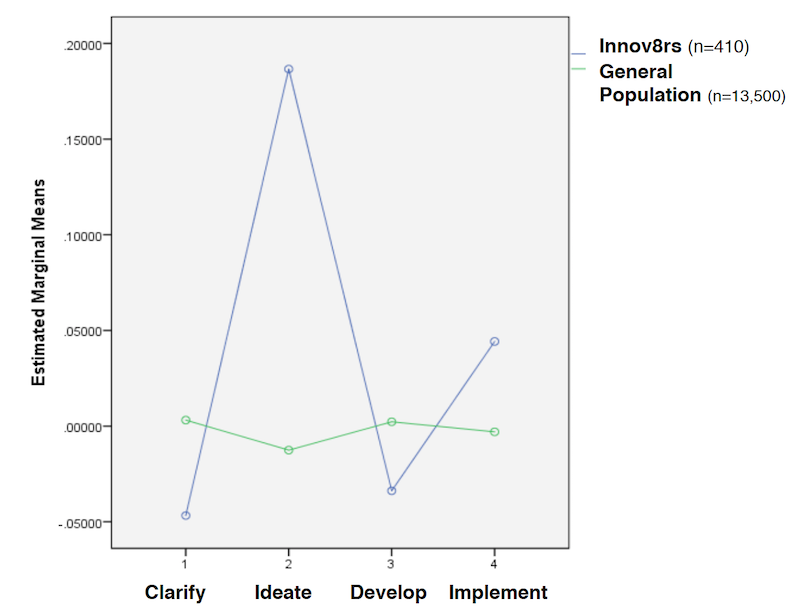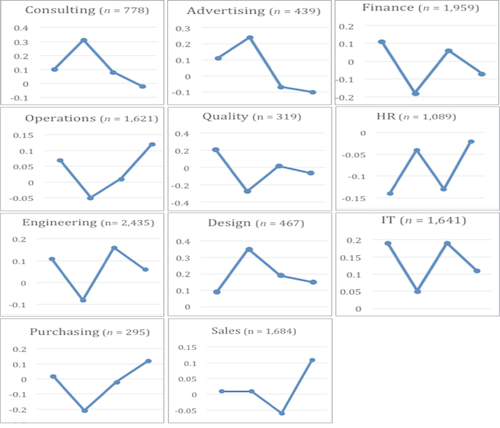In 2018, in partnership with FourSight and BridgePoint Effect, we embarked on the first global research project to better understand who we are as corporate innovators from a cognitive perspective.
Specifically, the goal of the study was to reveal the thinking profile of corporate innovators. Is it different from the general populace? Are there distinguishing characteristics of people who are drawn to corporate innovation?
To measure the cognitive profile of innovators, we used the FourSight Thinking Profile, a research-based assessment that helps individuals and teams understand their preferences for engaging in creative process, and what this means to how they approach problem-solving and innovation. We collected more than 400 thinking profiles of innovators based from Los Angeles to Sydney and compared these with 13,500 assessments from the general population.
What we found was astonishing.
The 4 thinking styles
First some background.
Innovation is a manifestation of creative problem-solving. From the science of creativity, we know that innovation calls upon four different styles of thinking. There is clarifying the challenge, generating ideas, developing solutions and implementing them. These thinking styles are very different, and often at odds.
The FourSight Thinking Profile, which measures an individual’s thinking preferences for each problem-solving stage, shows that these thinking styles are embodied in people, who are very different and often find themselves at odds when they try to solve problems together.
Here’s how each of the four primary styles (Clarifier, Ideator, Developer and Implementer) engage in innovation.
Clarifiers do their homework
The Clarifier wants to spend time validating the challenge before they try to solve it. They make fact-based associations and decisions, moving forward cautiously and systematically to make sure the team is asking the right questions and heading towards the right target before taking off.
Clarifiers prefer working with: other Clarifiers, and sometimes Developers
They thrive at the pre-discovery part of the innovation cycle (i.e. competitive analysis, consumer behavior, validating proposition, strategic direction).
Ideators think big
Ideators use their imaginations to make connections and play with ideas to achieve novel outcomes. They get the big picture, and they don’t mind staying at an abstract level where the details aren’t all fleshed out. New ideas excite them, and they are happy jumping from idea to idea.
They prefer working with anyone; unfortunately, the feeling isn’t mutual!
They thrive in the discovery part of the innovation cycle (i.e. design thinking, brainstorming, idea generation).
Developers get things right
Will the idea work in the real world? The Developer makes sure it will, taking their time to test the solution, paying close attention to explore every detail and permutation of the problem, so they can make sure it gets addressed. Developers are meticulous and careful, taking their time to get into the weeds and identify every loophole and eventuality.
Developers prefer working with other Developers, and sometimes Clarifiers.
They thrive in the development part of the innovation cycle (prototyping solutions, product testing).
Implementers get the job done
Implementers hit the ‘go live’ button: They like to fail fast, dust themselves off and go full-speed ahead again for the maximum outcome and results. Often excitable and high-energy players in the innovation cycle, Implementers don’t suffer excuses for delays. To them, development details feel like wading through oatmeal.
Implementers prefer working with: other Implementers
They thrive in the delivery part of the innovation cycle (i.e. product delivery, promotions, sales).
What about innovators?
So which of those cognitive preferences do innovators share? In the research study, FourSight and Innov8rs collected more than 400 thinking profiles of innovators on four continents. We queried innovators from Atlanta and Los Angeles to Sydney and from Madrid to Tel Aviv, and compared these with 13,500 assessments taken over the same time period from the general population.
The results were striking. Through the lens of the FourSight Thinking Profile, corporate innovators show an overwhelming preference for ideation.
It makes intuitive sense. Ideators are naturally attracted to novelty, variety and change. They like to start with a whiteboard and brainstorm their way to a breakthrough rather than follow a prescribed path. They don’t mind bucking the status quo. They tend to choose originality over conformity and adventure over routine.

The research results show that, in addition to a high preference for ideating, innovators also have a high preference for implementing. Meaning, they don’t just enjoy new ideas, they like to make them happen. And if they fail, they’ll just come up with another idea and try again. Other groups with the same combined Ideator + Implementer profile include entrepreneurs and executives.
The graph of innovators also reflects some low preferences, namely for clarifying and developing, the stages in problem-solving that call for more meticulous analysis and conscientious, detail-driven rigor. Groups with a high preference for clarifying and developing include engineers, finance and IT.
It takes a team to create value at scale
If innovation is “the ability to create new value at scale,” then innovators clearly gravitate toward the “new value” part. They flock to hackathons, incubators, accelerators, design thinking, idea capture systems, and agile all as vehicles for people to surface fresh ideas and spur breakthroughs.
But creating new value is only half of that definition of innovation. It’s missing “at scale,” which is the part where you bring your idea to everyone.
Scaling is a little slower. It takes time. It takes a team, and probably not just one team. Scaling often calls for the collaboration of diverse organizational functions, requiring engineering, finance and IT to get involved to make a new idea happen at scale.
And herein lies an almost universal challenge for innovators solving complex problems: other people. Let’s imagine four people are tasked to draw a picture of a bat.
- One scribbles multiple variants of a winged animal.
- The second wants to research wing dimensions before putting pen to paper.
- The third copies a realistic portrait of a furry creature flying through the night sky.
- And the fourth draws a baseball bat.
All of these approaches could be correct, but they have vastly divergent outcomes. Likewise, the issue with innovation is not the diversity of ideas, but the diversity in the very perception of what the problem is and how best to solve it.
Originality or conformity?
If innovators thrive on originality and inventiveness, the people they consider their opposites are drawn towards conformity, rules and guardrails. The difference engenders mistrust.
Innovators complain that conformists kill innovation, hinder progress and stunt the inception of new ideas. Conformists complain that innovators are disruptive, unreliable and entirely out of touch with reality.
Eventually, the two become enemies and resolve that others must pick a camp. So, is it conformity or originality? Do you want to push the envelope, or play it safe?

This tribal approach eventually leads to the worst of both worlds.
Innovation isn’t a tug-of-war between original thinkers and conformists. It’s more like the dynamic interplay of inhaling and exhaling. It succeeds when there is a seamless exchange between the creation of new ideas and the stable refinement and adoption of profitable solutions.
Successful innovation may begin with a breakthrough, but crossing the finish line demands harnessing the stable, cautious structured energies that innovators often see as oppositional to their goals.
What innovators need to succeed
There is a paradox here of course. As innovators, we pride ourselves on the breadth of our vision, our openness to ideas, our tolerance of difference. But often, we too are guilty of silo thinking and tribalism. We become tired of traditional methods, intolerant of incremental change, restless with routines and reluctant to work with “boring” people.
Why?
The simple fact is that we sometimes like ourselves a little too much. It’s a phenomenon found throughout FourSight research: People with a shared cognitive profile feel most at home with others like themselves.
Management books tout the virtues of innovators as being tolerant of failure, willing to experiment, non-hierarchical, and so on. These are good things, right? Well… no. These are highly functional in some contexts but disastrous in others. Successful innovators need to acknowledge their natural strengths and potential weaknesses in the eyes of others.
As high Ideators, we assume we can inspire anyone with our vision, ideas, passion and zealous confidence. We remain oblivious to the need that Clarifiers and Developers have to understand exactly how our big idea will make the organization more secure, stable, strong and profitable. They are not only deaf to passion, they are allergic to it. They simply won’t believe it if there is no science, research, precedent or prototype to prove it. Without the information they need, they cannot help make your idea part of the system.
How moonshots really achieve lift off
Our overwhelming desire to stay in our tribe and take moonshots can cause us to undervalue the traits and characteristics we lack and avoid the very people who can guarantee our success at scaling our innovations.
It’s time for innovators to extend the tribe beyond Ideators and learn to collaborate more effectively with people who bring an entirely different set of problem-solving preferences to the party, people who can help us turn our shining ideas into workable, predictable, scalable and profitable solutions.
If we leverage cognitive diversity by forming an alliance with those whom we see as opposites, we have much to learn and even more to gain from collaborating with those who love the work we shun. Indeed- we need this awareness to put our moonshot ideas into the hands of people who can help them achieve lift off.
If you’re interested in getting the full report of our joint research with FourSight, or if you’d like to know more about how FourSight can help to make innovation succeed at your organization, contact us here.

